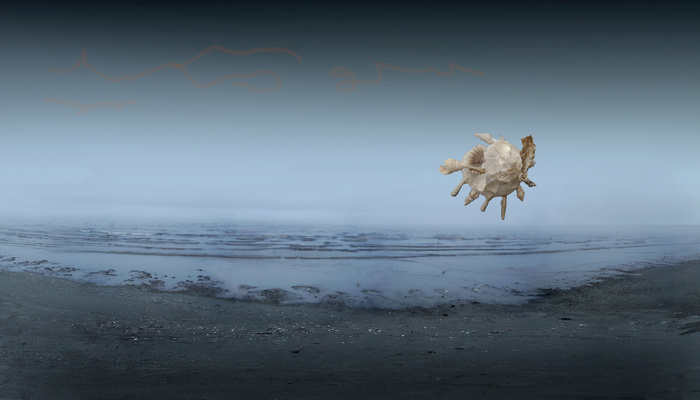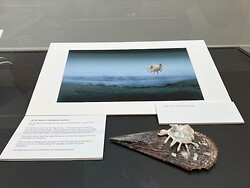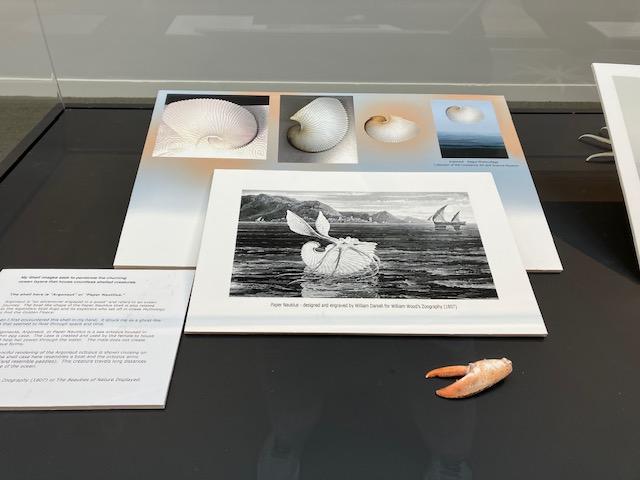Shell Travel
28th August 2024
In my recent exhibit "Following Henry"(see previous post- talking Thoreau here) I included a few images from my Ocean/Shell series (with shells) to fill the display cases and add a bit of entertainment.
Shipwrecks were common in Thoreau's era globally. Powerful seas tossed wooden hulls into rocks or simply threw them over.
The same seas moved seashells about for centuries and beyond, but shelled creatures are better able to withstand a little wind and water.
The travel of seashells seems mysteriously random, but that is my impression because I cannot see them on their journeys.
I can only imagine where they have been after I pick one up on the beach.


Yes there is a shelled creature that collects smaller shells, attaches them with secreted "glue" and carries the appendages along. A general term for this resourceful construction is the "carrier shell."
Another shell (below) imbued with special travel skills is the Paper Nautilus - also called Argonaut. A short discussion of this traveler is in a News Post here on my website - scroll down to July 2021.
l was happy to find an antique engraving showing the Argonaut sailing on the ocean. A detailed description is directly below the photo below.

The shell featured above is "Argonaut" or "Paper Nautilus."
Argonaut is "an adventurer engaged in a quest" and refers to an ocean journey.
The boat-like shape of the Paper Nautilus shell has also been mythically linked
to the legendary boat Argo and the explorers who set off in Greek lore to find
the Golden Fleece.
When I first encountered this shell in my hand, it struck me as a ghost-like
form that seemed to float through space and time.
The Argonauta, Argonaut, or Paper Nautilus is a sea octopus housed in a
paper-thin egg case. The case is created and used by the female to house eggs
and help her power through the water. The male does not create these unique forms.
One early fanciful rendering of the Argonaut octopus is shown cruising on
the ocean. The shell case here resembles a boat and the octopus arms become
sails (and resemble paddles). This creatures travels long distances near
the surface of the ocean.
The print of the boating Argonaut is from the 1807 publication by William Wood
titled Zoography or The Beauties of Nature Displayed.
Shipwrecks were common in Thoreau's era globally. Powerful seas tossed wooden hulls into rocks or simply threw them over.
The same seas moved seashells about for centuries and beyond, but shelled creatures are better able to withstand a little wind and water.
The travel of seashells seems mysteriously random, but that is my impression because I cannot see them on their journeys.
I can only imagine where they have been after I pick one up on the beach.


Yes there is a shelled creature that collects smaller shells, attaches them with secreted "glue" and carries the appendages along. A general term for this resourceful construction is the "carrier shell."
Another shell (below) imbued with special travel skills is the Paper Nautilus - also called Argonaut. A short discussion of this traveler is in a News Post here on my website - scroll down to July 2021.
l was happy to find an antique engraving showing the Argonaut sailing on the ocean. A detailed description is directly below the photo below.

The shell featured above is "Argonaut" or "Paper Nautilus."
Argonaut is "an adventurer engaged in a quest" and refers to an ocean journey.
The boat-like shape of the Paper Nautilus shell has also been mythically linked
to the legendary boat Argo and the explorers who set off in Greek lore to find
the Golden Fleece.
When I first encountered this shell in my hand, it struck me as a ghost-like
form that seemed to float through space and time.
The Argonauta, Argonaut, or Paper Nautilus is a sea octopus housed in a
paper-thin egg case. The case is created and used by the female to house eggs
and help her power through the water. The male does not create these unique forms.
One early fanciful rendering of the Argonaut octopus is shown cruising on
the ocean. The shell case here resembles a boat and the octopus arms become
sails (and resemble paddles). This creatures travels long distances near
the surface of the ocean.
The print of the boating Argonaut is from the 1807 publication by William Wood
titled Zoography or The Beauties of Nature Displayed.